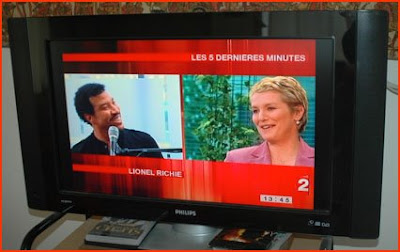One of the joys of living in the country is that, when you wake up in the morning, you never know what kinds of situations you might find yourself in during the day. This morning, I was woken up by the noise of a tractor on the road up to Gamone. It was the municipal employee of Choranche,
Pierre Faure, cleaning up the edges of my road.

As you can see, Pierrot (as we call him) was combining roadworks with baby-sitting. In fact, for Pierrot, working at Gamone is a kind of recreation, which he seems to enjoy. Even when there's little more than a few stones and scattered leaves on the macadam, Pierrot can spend hours scraping away (at my land, that is, on either side of the road) until the road looks like the head of a little boy, almost bald, who was sent to the barber's shop by his mother for a military-type "short back and sides". I've always disagreed with Pierrot in this domain. I believe that no problems would arise if Pierrot were simply to let the grass grow a bit alongside the road, instead of creating vertical walls of bare earth, sometimes 50 cm high. But rural natives like Pierrot grow up with the ingrained idea that grass and weeds are necessarily unkempt, indeed "dirty", and must be eliminated. For me, on the contrary, lots of grass and a few weeds at Gamone don't bother me at all. The only things that would drive me mad are candy wrappers, cigarette butts, plastic bags... which are fortunately absent here.
I received the planned visit at nine o'clock of another municipal employee, attached to the group of communes on the banks of the Bourne, who's in charge of inspecting sewage installations. A new law was voted in France, a couple of years ago, instigating a regular nation-wide inspection of sanitary systems in every corner of the country. On TV, a few evenings ago, there was a short news documentary on this exotic subject. In many cases, in suburban and rural environments, people simply don't know where their septic tank is located, or in what state it might be. They showed a case where an inspector, to find the septic tank, had to tear up the floor boards of a living room.

Here at Gamone, the septic tank is located twenty yards down from the house. Knowing that the inspector was coming, I had to spend a few hours locating the tank, which involved removing thorn bushes and even a layer of earth that had glided down that way about ten years ago, when a local fellow removed a giant linden tree that had been blocking the afternoon sunshine. The inspector suggested that I purchase a black plastic cylinder, to raise the access to the tank... which I'm encouraged to inspect once every six months. My installation is in a faultless state (the inspector even delivered a signed certificate), but he suggested that I should renew the bed of volcanic rocks (I'm not joking) at the top of the tank, which operate as a filter, so that the charming little bacteria (which need to breathe, if I understand correctly) can carry out their work in optimal conditions.
Now that's where things get interesting. I had no trouble finding the black plastic cylinder in a hardware store. But where does one purchase volcanic rocks? No problem. This stuff is available in a depot down in the delightful village of Saint-Nazaire-en-Royans, where the Bourne flows into the Isère.

But volcanic rocks are not exactly an ordinary product, and this depot is not the kind of place where you buy stuff like in a store. Upon my arrival, a secretary told me to put my automobile on a weigh-bridge, then a worker handed me a shovel and pointed to a remote corner of the depot where there was a huge pile of volcanic rocks. Fortunately, I had an empty plastic bin in the car, so I backed my vehicle up against the rocks and used the shovel to fill the bin... while admiring the glorious river scene, surrounded by gentle slopes: a former port, called Roquebrune, where the Chartreux monks used to put mountain timber on rafts that would float all the way down to Provence. Then I drove back to the weigh-bridge, where I was informed that my purchase would cost me a total of fifty cents.

Looking back over my day, I realize that, when I woke up this morning, I was completely ignorant of the subtle relationship between shit-eating bacteria and fragments of dusty red rock that were formed long ago when the province of Auvergne was the scene of volcanoes. So, I'm a little more knowledgeable now. This morning, I didn't imagine that I would get around to talking, in this blog, of my septic tank. But, as I said at the beginning, when you live in the country, you never know what's going to happen.
 This French frigate is part of the Atalante task force set up by the European Union with the aim of combatting piracy in that region.
This French frigate is part of the Atalante task force set up by the European Union with the aim of combatting piracy in that region.















































